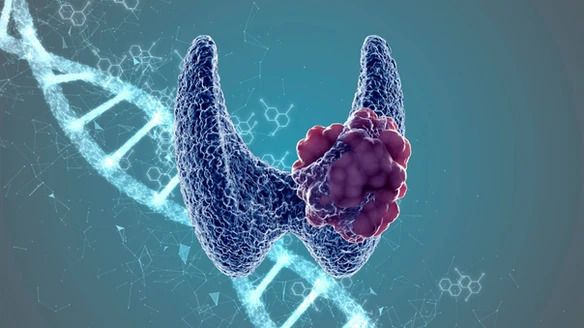- Marcos Santos, Ph.D
- 0 Comments
- 39643 Views
If you have identified a thyroid nodule and your doctor has recommended (or you have already undergone) a fine-needle aspiration biopsy (FNA) of this nodule, you have probably come across the term “Bethesda”.
The term “Bethesda” refers to a system created to standardize the worldwide reporting of thyroid nodule FNA results. It is an attempt to make sure that all doctors speak the same language when they treat, study, and evaluate a thyroid nodule through FNA. This classification system was named after the scientific meeting that discussed its creation, which took place in Bethesda, United States.
But what is the Bethesda System exactly?
What is Bethesda System?
The Bethesda System is a “Risk of Malignancy” scale (probability of cancer) based on the analysis of cells collected during the FNA procedure (referred to as cytological analysis).
This system establishes a set of categories ranging from I to VI, with each category representing a percentage of cancer risk. The risk can range from 0-3% for category II (termed “benign” due to the very low probability of the nodule being malignant) to approximately 98% for category VI (termed “malignant” due to the very high probability of it being cancer).
The category I is used when the quantity or quality of cells collected during FNA is unsatisfactory, preventing the pathologist from categorizing the sample in a standardized manner. Each category is formulated based on the characteristics of the cells found in FNA, as seen on the table below:

How is the Bethesda System used in practice?
In practice, the patient undergoes a fine-needle aspiration of the thyroid nodule, and then the pathologist categorizes the sample into one of the Bethesda categories based on the cytological characteristics of that nodule. Each category is associated with a different risk of cancer and, therefore, linked to a specific medical recommendation. These recommendations can range from repeat FNA, active surveillance of the nodule, molecular testing, to surgery for partial or total removal of the thyroid.
Recommended clinical management according to each Bethesda category
Since its creation, the system has provided a means of communication among physicians involved in the patient’s care, offering useful information and guidance on how to proceed after FNA. It’s important to note that these are only recommendations for common management, as the optimal management of each patient is individualized and determined by the attending physician.

*Management recommendation: Current management depends on various factors, including clinical and sonographic features, patient preference, and medical decision. The 2017 update of the system included molecular testing as a management recommendation for Bethesda III or IV nodules.
Bethesda I: Non-diagnostic or unsatisfactory sample.
This category includes samples that do not meet the minimum criteria for analysis, either due to an insufficient quantity of cells or excessive blood in the sample, for exemple. This category is crucial as it identifies inadequate samples that could result in false positives or false negatives. Usually, repeat FNA guided by ultrasound is recommended.
Bethesda II: “Benign” nodule (high probability of not being cancer).
This result is obtained in up to 60% of cases. Generally, Bethesda II thyroid nodules do not need to be removed unless they are causing symptoms such as difficulty breathing, swallowing, or aesthetic concerns. As a general practice, surveillance of the nodule with ultrasound follow-up is the most appropriate approach.
Bethesda III or IV: Indeterminate nodule.
This diagnosis can occur in up to 30% of cases and means that, although an adequate number of cells have been collected during FNA, the microscopic examination cannot reliably classify the result as benign or cancerous. Several studies suggest that indeterminate nodules are malignant in only 20-30% of cases. Since it is a potential tumor, the standard procedure is to surgically remove the nodule.
However, considering that the majority of these nodules (70-80%) are benign, surgery may often be unnecessary. Molecular tests such as mir-THYpe full are recommended in these cases as an alternative for resolving the uncertainty and ambiguity of an “indeterminate” diagnosis.
Bethesda V or VI: Suspicious (V) or malignant (VI) nodule.
These results are typically obtained in approximately 7% of test outcomes. In these cases, partial or total removal of the thyroid gland is usually indicated. Thyroid surgeries are not the same for all patients, as many variables can arise during the process. There are molecular characteristics of the nodule that can indicate the extent of the surgery, whether it needs to be performed with different levels of urgency, or even determine the aggressiveness of the analyzed nodule. Molecular tests such as mir-THYpe pre-op can assist in these situations by aiding in the analysis of these nodular characteristics.

How does molecular testing for indeterminate nodules (Bethesda III or IV) work, and how can it help in clinical practice?
When a nodule is classified as indeterminate, it means that the cytological characteristics observed during FNA were not sufficient to determine whether it is benign or malignant. The mir-THYpe full molecular test analyzes the molecular information within the cells of the nodule using the same FNA sample collected from the patient. Through molecular biology techniques and artificial intelligence, it can indicate whether the nodule is potentially benign or malignant.
How does the result of the molecular test assist the physician in making a decision regarding an indeterminate nodule?
If the result indicates that the nodule is potentially benign, thyroid surgery can be avoided since the physician’s approach to a negative result in the molecular test would be similar to a benign result in the Bethesda System: surgery is generally not necessary, and the nodule can be monitored.
If the result indicates a potential malignancy in the molecular test, surgery is likely to be recommended. In this scenario, the molecular test analyzes markers that indicate the aggressiveness of the nodule, helping in the decision-making process regarding the extent of surgery (i.e., whether it will be a partial or total thyroidectomy). This contributes to personalized surgery for each patient and reduces subjectivity.
How can mir-THYpe pre-op assist in nodules with an indication for surgery (Bethesda V or VI)?
If the nodule is already classified as Bethesda V or VI during FNA, it already has an indication for surgery. In this situation, it is suggested to perform the molecular test that analyzes only the prognostic markers, indicating whether the nodule will be more or less aggressive and helping the physician in determining the surgical approach and urgency mentioned above. The recommended test for this scenario, which analyzes only the prognostic markers, is mir-THYpe pre-op. It investigates DNA mutations and microRNA expression in the nodule, aiding the physician in a more personalized surgery based on the characteristics of each patient’s nodule.
Discuss this possibility with your doctor! The recommendations provided in this post are for informational purposes only and do not replace medical consultation.
References:
- The 2017 Bethesda System for Reporting Thyroid Cytopathology | Thyroid- https://www.liebertpub.com/doi/full/10.1089/thy.2017.0500
- American Cancer Society. https://www.cancer.org/cancer/thyroid-cancer/about/what-is-thyroid-cancer.html
- Bongiovanni M, et al. 2012 Acta Cytologica






